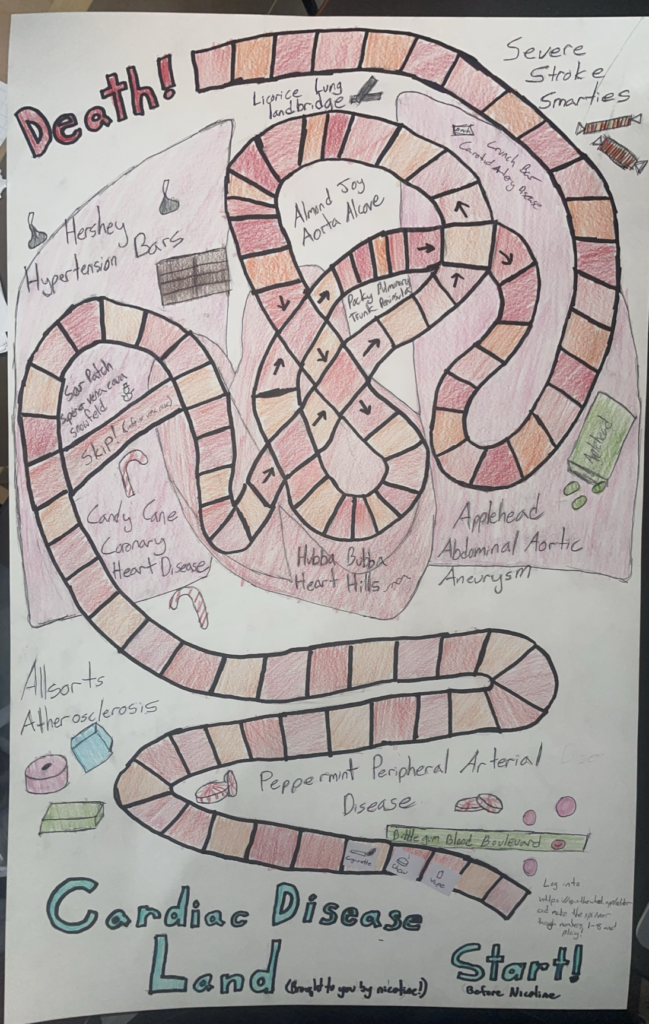
The objective being covered in this project is regarding the cardiovascular system with the question: “Explain how the heart translates an electrical signal to a contraction”. Additionally, the question of how nicotine can affect this process and explain the positive correlation between elevated heart rate as a result of nicotine, and common cardiovascular disease that results from nicotine consumption. In short, an electrical signal is generated within the heart via the sympathetic system. Electrical signaling in the heart begins with the sino-atrail (SA) node (natural pacemaker of the heart) in the upper right chamber of the heart which will then cross into the atria causing them to have a small contraction while blood is pumped through the valves into the ventricles. Then the signal will activate the atrioventricular (AV) node, and then the electrical signal will travel through conduction pathways that travel down the heart into the bottom right and left ventricles which will then trigger a contraction within those ventricles of the heart and pump blood through the pulmonary or aortic valves. This is ideally how the heart should work.
When nicotine is introduced, it acts as an agonist for acetylcholine causing it to bind to acetylcholine receptors and increase the effect of acetylcholine within the synapse of the nerves essentially causing the nerve to fire more rapidly. The myocardial work output increases because the action potential of the cardiac cells that receive electrical signaling increases, causing an increase in blood pressure, heart rate, and myocardial contractility. Excess strain as a result of the elevated heart rate and the increase in blood pressure causes plaque (a combination of fat, cholesterol, and other debris) to build up in the coronary arteries and throughout the cardiovascular system which narrows the path that blood needs to take to deliver oxygenated or deoxygenated blood to its respective locations. When all of that plaque builds up, it causes the walls of the arteries and veins to become hard which makes a blockage as a result of a blood clot or a ton of plaque forming which will result in a heart attack or stroke depending on the location. All of these symptoms will thus cause conditions such as stroke, coronary heart disease, carotid artery disease, peripheral arterial disease, and abdominal aortic aneurysm. Getting into the specifics, all types of atherosclerosis but most likely coronary heart disease which occurs when plaque builds up in the arteries responsible for supplying blood to the heart, a peripheral arterial disease that causes plaque buildup in the arteries of the extremities which results in possible amputation, and lastly carotid artery disease which is plaque buildup in the neck arteries. Lastly, an abdominal aortic aneurysm occurs when the walls of the aorta become weak due to smoking which causes it to burst and cause a severe aneurysm which most often results in death. Any sort of plaque or blood clot that occurs in or around the heart or head will result in either a heart attack or stroke, all resulting from consuming any nicotine at all.
References
American Heart Association. (2022). How High Blood Pressure Can Lead to a Heart Attack. Www.heart.org. https://www.heart.org/en/health-topics/high-blood-pressure/health-threats-from-high-blood-pressure/how-high-blood-pressure-can-lead-to-a-heart-attack#:~:text=The%20excess%20strain%20and%20resulting
Anatomy and Function of the Heart’s Electrical System. (n.d.). Www.hopkinsmedicine.org. https://www.hopkinsmedicine.org/health/conditions-and-diseases/anatomy-and-function-of-the-hearts-electrical-system#:~:text=The%20sinus%20node%20generates%20an
Devi, M. R. R. (2013). ECG Changes in Smokers and Non Smokers-A Comparative Study. JOURNAL of CLINICAL and DIAGNOSTIC RESEARCH. https://doi.org/10.7860/jcdr/2013/5180.2950
Effect of Nicotine and MSG on Neurons. (n.d.). Backyardbrains.com. https://backyardbrains.com/experiments/teachersguide/neuropharmacology#:~:text=Nicotine%20is%20an%20agonist%20for%20acetylcholine%2C%20so%20it%20binds%20to
Haass, M., & Kübler, W. (1997). Nicotine and sympathetic neurotransmission. Cardiovascular Drugs and Therapy, 10(6), 657–665. https://doi.org/10.1007/bf00053022
Heidland, U. E., & Strauer, B. E. (2001). Left Ventricular Muscle Mass and Elevated Heart Rate Are Associated With Coronary Plaque Disruption. Circulation, 104(13), 1477–1482. https://doi.org/10.1161/hc3801.096325How the heart works. (n.d.). Www.nhsinform.scot. https://www.nhsinform.scot/illnesses-and-conditions/heart-and-blood-vessels/about-the-h

This is a really creative project and I really enjoyed it. I liked how you made the different lands different diseases, it was very creative. With the different types of candy, I thought that was very cool. I liked how you incorporated nicotine into it, it really goes with today’s society and using this can help people today. It is amazing how the heart can send electrical signals to the brain to pump the heart. Nicotine has a great effect on this and it is great to know the risks. Great job!